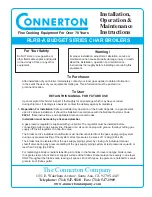
WHL-016 Rev. 4.14.16
37
NOTES:
1. Condensate line must be pitched at least ¼” per foot to
properly drain. If this cannot be done, or a very long length
of condensate hose is used, increase the condensate line
to a minimum of 1” ID and place a tee in the line after the
condensate neutralizer to properly reduce vacuum lock in the
drain line.
2. PVC or CPVC pipe should be the only material used for
condensate line. Steel, brass, copper, and other metals will be
subject to corrosion or deterioration.
3. A frozen condensate line could result in a blocked vent
condition. It is very important to protect the condensate
line from freezing temperatures or any type of blockage.
In installations that may encounter sustained freezing
conditions, the use of heat tape is recommended to avoid
freezing of the condensate line. It is also recommended to bush
up the condensate line size to 1” and terminate condensate
discharge as close to the unit as possible. Longer condensate
runs are more prone to freezing. Damages due to frozen or
blocked condensate lines ARE NOT covered by warranty.
4. Support of the condensate line may be necessary to avoid
blockage of the condensate flow.
5. To allow proper drainage on longer horizontal condensate
runs, tubing size may need to increase to 1” and a second line
vent may be required.
NOTE:
To clean out condensate trap, see Maintenance
section.
The condensate line must remain unobstructed. If allowed to
freeze in the line or obstructed in any other manner, condensate
can exit from the boiler tee, resulting in potential water damage
to property. When installing a condensate pump, select one
approved for use with condensing boilers and furnaces. The
condensate pump should have an overflow switch to prevent
property damage from spillage. Condensate from the boiler will
be slightly acidic (pH from 3.2 to 4.5). Install a neutralizing filter
if required by local codes.
Is is very important that condensate piping be no smaller than
3/4”. Use a tee at the condensate connection with a branch
vertically up and open to the atmosphere to prevent a vacuum
that could obstruct the flow of condensate from the boiler. To
prevent sagging and maintain pitch, condensate piping should
be supported with pipe supports.
When installing a condensate pump, select one approved for
use with condensing boilers and furnaces. The pump should
have an overflow switch to prevent property damage from
condensate spillage.
Figure 26 - Condensate Piping Suggestions
Power to the optional condensate pump is continuous. When
the boiler is powered off the condensate pump will remain on.
It is important to remember to turn off the condensate pump
when powering down the boiler. Failure to do so could result in
property damage, severe personal injury, or death.
Summary of Contents for WBC 399
Page 14: ...WHL 016 Rev 4 14 16 14 Figure 6 Boiler Dimensions NOTE All Dimensions Are Approximate 055 080 ...
Page 21: ...WHL 016 Rev 4 14 16 21 Figure 9 Piping Symbol Legend ...
Page 42: ...WHL 016 Rev 4 14 16 42 Figure 33 Internal Connection Diagram ...
Page 65: ...WHL 016 Rev 4 14 16 65 Figure 37 Combustion System Replacement Parts 55 110kBTU Models ...
Page 67: ...WHL 016 Rev 4 14 16 67 Figure 39 Combustion System Replacement Parts 155 399kBTU Models ...
















































